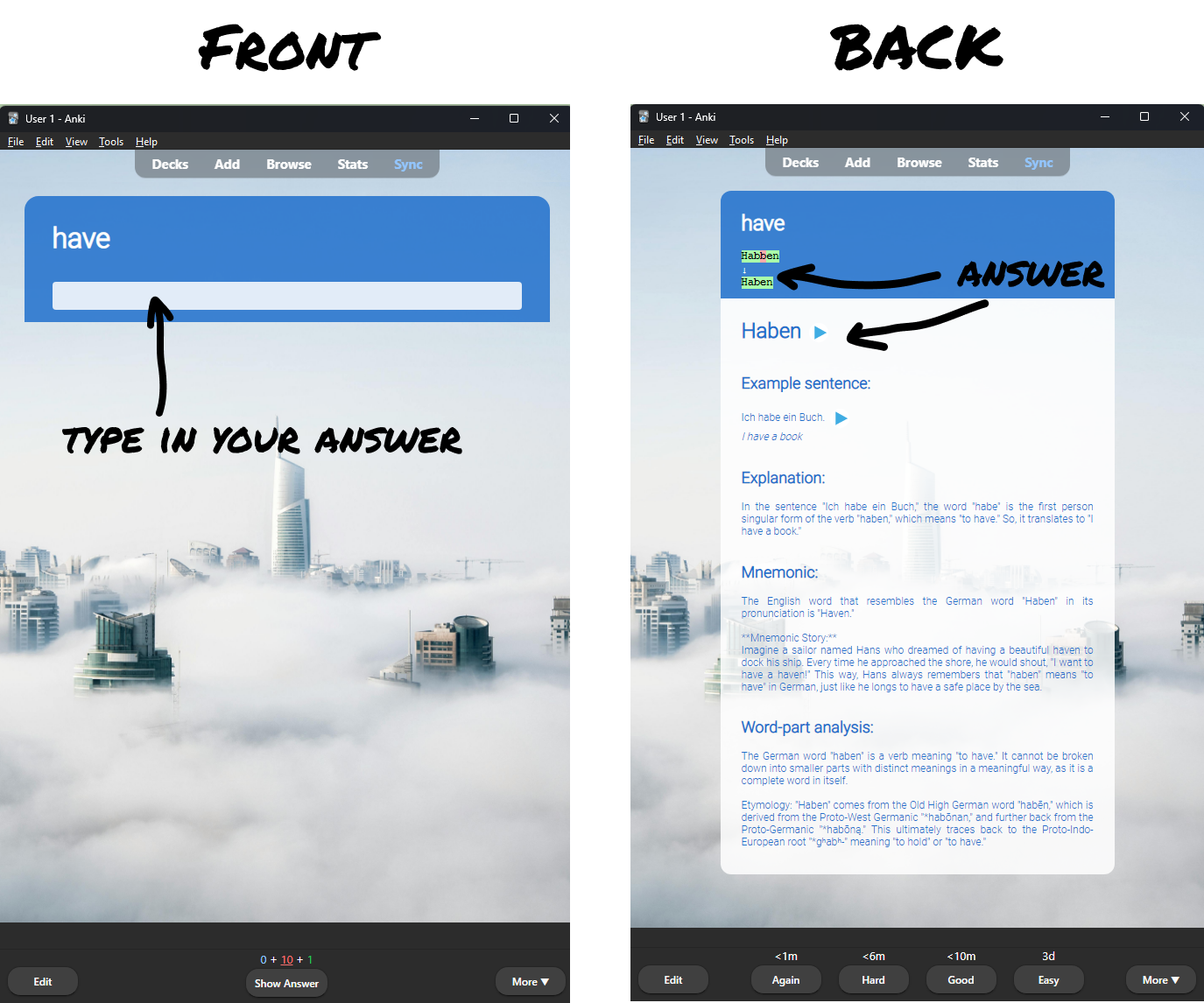The Only Flashcard Decks You'll Ever Need
Unmatched in Depth & Coverage
The Anki Core Decks are flashcard decks compatible with Anki.
What are the Anki Core Decks?
The Anki Core Decks are flashcard packages for learning languages.
Once you buy an Anki Core Deck, you can import it into Anki, which is a free and popular app for learning languages using flashcards.
You don't need to know how to use Anki. Your Anki Core Deck comes with detailed instructions on how to use Anki.
Example flashcard
Here is a flashcard from the German deck. Keep in mind, they are customizable. You can change the layout however you want.

Anki Core Spanish
Anki Core French
Anki Core German
Anki Core Japanese
Anki Core Italian
Anki Core Korean
This deck is comming soon!

ALL the vocabulary you'll EVER need
Your Anki Core Deck is the only deck you'll ever need to become fluent in your target language. With 8,000 to 11,000 flashcards, you'll be fluent by the end.
Here's what you can expect from each flashcard:
The target word
8,000 to 11,000 words in total, sorted by frequency. Audio is also included, so you know how to pronounce the word.
Example sentence
Every word has an example sentence. The sentences are easy at first (A1 level) and get harder as you progress through the deck (C1 level). Audio is also included.
Explanation
Every flashcard has an explanation of how the word was used in the example sentence.
Mnemonic
You also get a mnemonic that associates the word in your target language with the word in English. This technique (called the "keyword technique") has 70+ backing up its efficiency.
Word-part analysis
Some flashcards have an analysis of the different components of the word. This is also a technique proven to enhance learning. In the case of words that can't be broken down, you'll get the etymology of the word.
Stop wasting time
The Anki Core Decks provides curated flashcard decks for language learners. Our decks are designed to optimize language acquisition by focusing on the 8,000 to 11,000 most common words in your target language.
Here's why frequency matters:
Optimal Use of Your Time: We know your time is precious. The Anki Core Decks ensure you spend it wisely, learning words that you'll encounter most often in real-life situations. Say goodbye to wasting time on obscure vocabulary!
Enhanced Understanding: Struggle with comprehension no more! By mastering these common words, you'll understand conversations and texts with ease, even if you don't know every single word.
Solid Learning Foundation: Build a strong foundation with high-frequency words. Once you've got these down, expanding your vocabulary becomes a breeze, paving the way for advanced language skills and deeper understanding.


Thorough vocabulary coverage
A lot of decks make the mistake of not including word variations. For example, a word like "creative" may be excluded from these decks, because they already contain "create".
This is not the case for the Anki Core Decks. Here's why we kept some word variations:
1. Comprehensive Understanding of Words: Including variations of word families helps you grasp the full scope of a word's meaning and usage. For instance, knowing "create" and "creative" allows you to understand the root word "create" in different contexts and forms, which deepens your comprehension.
2. Improved Morphological Awareness: Exposure to word families aids in the development of morphological awareness, the ability to understand and manipulate the structure of words. This skill is crucial as it enhances your ability to decode new words, infer meanings, and recognize grammatical relationships within sentences.
3. Increased Vocabulary Retention: Learning words in families can improve retention by creating mental associations. When you see how words are related, you can better remember and recall them.
1 million sentences analyzed
How do you really determine the frequency of a word?
You have to count how many times it is used!
To build the Anki Core Decks, 1 million carefully selected sentences were analyzed. All the sentences were provided by the Leipzig University, in Germany. You can learn more about the sentences here.
The result of this computer analysis is a comprehensive list of the 8,000 to 10,000 most used words in the language.


Improve retention by 20 to 25%
Mnemonics are underused.
In fact, when I talked with Professor Paul Nation, he said that there currently are 70+ studies showing the power of the keyword technique (a type of mnemonic) for learning languages.
He also said that the keyword technique improves learning by 20 to 25%.
The keyword technique, as explained by Professor Paul Nation, is a mnemonic method used to enhance vocabulary learning. It involves creating a mental link between the new word and an already familiar word (the keyword) that sounds similar.
This technique has two main steps:
1. Acoustic Link
The learner finds a keyword in their native language that sounds like or reminds them of the new word they are trying to learn. This keyword acts as a bridge between the new word and something familiar.
For instance, if the learner is trying to remember the Spanish word "caballo" (horse), they might use the English word "cabin" as a keyword because "caballo" sounds somewhat similar to "cabin."
2. Imagery Link
The learner then creates a vivid mental image that connects the keyword with the meaning of the new word. In our example, the learner might imagine a horse inside a cabin to link "caballo" (horse) with "cabin."
By combining these two links, the keyword technique helps in encoding the new word more effectively in the memory. The technique leverages the power of visualization and association, making it easier for learners to recall the word and its meaning later on.
Considering the power of mnemonics for language learning, I decided the Anki Core Decks had to have mnemonic.
As a consequence, each flashcard has a dedicated mnemonic.
About the developer
Learning a language without the guesswork
I have spent years thinking about language learning methods. This allowed me to learn multiple languages up to high levels (including English). On my YouTube channel, I share this information and I interview prominent figures in the language learning world.






